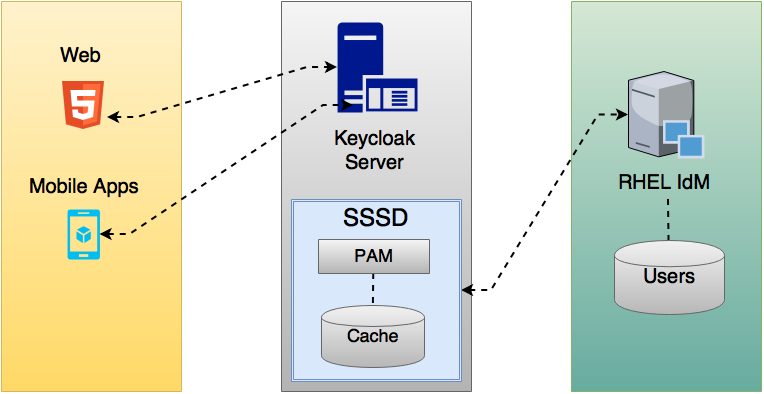SSSD and FreeIPA Identity Management integration
Keycloak includes the System Security Services Daemon (SSSD) plugin. SSSD is part of the Fedora and Red Hat Enterprise Linux (RHEL), and it provides access to multiple identities and authentication providers. SSSD also provides benefits such as failover and offline support. For more information, see the Red Hat Enterprise Linux Identity Management documentation.
SSSD integrates with the FreeIPA identity management (IdM) server, providing authentication and access control. With this integration, Keycloak can authenticate against privileged access management (PAM) services and retrieve user data from SSSD. For more information about using Red Hat Identity Management in Linux environments, see the Red Hat Enterprise Linux Identity Management documentation.

Keycloak and SSSD communicate through read-only D-Bus interfaces. For this reason, the way to provision and update users is to use the FreeIPA/IdM administration interface. By default, the interface imports the username, email, first name, and last name.
|
Keycloak registers groups and roles automatically but does not synchronize them. Any changes made by the Keycloak administrator in Keycloak do not synchronize with SSSD. |
FreeIPA/IdM server
The FreeIPA Docker image is available in Docker Hub. To set up the FreeIPA server, see the FreeIPA documentation.
-
Run your FreeIPA server using this command:
docker run --name freeipa-server-container -it \ -h server.freeipa.local -e PASSWORD=YOUR_PASSWORD \ -v /sys/fs/cgroup:/sys/fs/cgroup:ro \ -v /var/lib/ipa-data:/data:Z freeipa/freeipa-serverThe parameter
-hwithserver.freeipa.localrepresents the FreeIPA/IdM server hostname. ChangeYOUR_PASSWORDto a password of your own. -
After the container starts, change the
/etc/hostsfile to include:x.x.x.x server.freeipa.localIf you do not make this change, you must set up a DNS server.
-
Use the following command to enroll your Linux server in the IPA domain so that the SSSD federation provider starts and runs on Keycloak:
ipa-client-install --mkhomedir -p admin -w password -
Run the following command on the client to verify the installation is working:
kinit admin -
Enter your password.
-
Add users to the IPA server using this command:
$ ipa user-add <username> --first=<first name> --last=<surname> --email=<email address> --phone=<telephoneNumber> --street=<street> \ --city=<city> --state=<state> --postalcode=<postal code> --password -
Force set the user’s password using kinit.
kinit <username> -
Enter the following to restore normal IPA operation:
kdestroy -A kinit admin
SSSD and D-Bus
The federation provider obtains the data from SSSD using D-BUS. It authenticates the data using PAM.
-
Install the sssd-dbus RPM.
$ sudo yum install sssd-dbus -
Run the following provisioning script:
$ bin/federation-sssd-setup.shThis script makes the following changes to
/etc/sssd/sssd.conf:[domain/your-hostname.local] ... ldap_user_extra_attrs = mail:mail, sn:sn, givenname:givenname, telephoneNumber:telephoneNumber ... [sssd] services = nss, sudo, pam, ssh, ifp ... [ifp] allowed_uids = root, yourOSUsername user_attributes = +mail, +telephoneNumber, +givenname, +sn -
Run
dbus-sendto ensure the setup is successful.sudo dbus-send --print-reply --system --dest=org.freedesktop.sssd.infopipe /org/freedesktop/sssd/infopipe org.freedesktop.sssd.infopipe.GetUserGroups string:johnIf the setup is successful, you see the user’s group. If this command returns a timeout or an error, the federation provider running on Keycloak cannot retrieve any data. This error usually happens because the server is not enrolled in the FreeIPA IdM server, or does not have permission to access the SSSD service.
If you do not have permission to access the SSSD service, ensure that the user running the Keycloak server is in the
/etc/sssd/sssd.conffile in the following section:[ifp] allowed_uids = root, your_username
Enabling the SSSD federation provider
Keycloak uses DBus-Java to communicate at a low level with D-Bus. D-Bus depends on the Unix Sockets Library.
You can find an RPM for this library in the keycloak repository. Before installing this RPM, check the RPM signature using this command:
$ rpm -K libunix-dbus-java-0.8.0-1.fc24.x86_64.rpm
libunix-dbus-java-0.8.0-1.fc24.x86_64.rpm:
Header V4 RSA/SHA256 Signature, key ID 84dc9914: OK
Header SHA1 digest: OK (d17bb7ebaa7a5304c1856ee4357c8ba4ec9c0b89)
V4 RSA/SHA256 Signature, key ID 84dc9914: OK
MD5 digest: OK (770c2e68d052cb4a4473e1e9fd8818cf)Install the RPM using this command:
$ sudo yum install libunix-dbus-java-0.8.0-1.fc24.x86_64.rpmKeycloak uses JNA to authenticate with PAM. Ensure you have the JAN package installed.
$ sudo yum install jnaUse the sssctl user-checks command to validate your setup:
$ sudo sssctl user-checks admin -s keycloakConfiguring a federated SSSD store
After the installation, configure a federated SSSD store.
-
Click User Federation in the menu.
-
From the Add Provider list select sssd. Keycloak brings you to the sssd configuration page.
-
Click Save.
You can now authenticate against Keycloak using FreeIPA/IdM credentials.